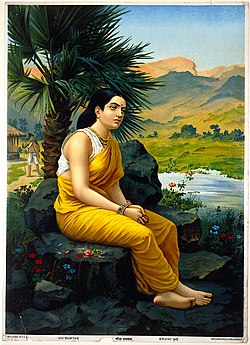| Sita Upanishad | |
|---|---|
 Sita | |
| Devanagari | सीता |
| IAST | Sītā |
| Title means | Goddess Sita |
| Date | 12th- to 15th-century[1] |
| Type | Vaishnava |
| Linked Veda | Atharva Veda[2] |
| Chapters | 1 |
| Verses | 37 |
| Philosophy | Vaishnavism, Vedanta |
The Sita Upanishad (Sanskrit: सीता उपनिषत्) is a medieval era Sanskrit text and a minor Upanishad of Hinduism. It is attached to the Atharva Veda,[3][2] and is one of the Vaishnava upanishads. It is categorized as a late Upanishad,[4] in which goddess Sita is extolled as the Ultimate Reality of the Universe (Brahman), the ground of Being (Spirituality), and material cause behind all manifestation.[5] The Upanishad identifies Sita with primordial Prakriti (nature) and her three powers, asserts the text, are manifested in daily life as will (iccha), action (kriyā) and knowledge (jnana).[6][4]
This Upanishad is notable for asserting that the cosmos is Atman (soul), it resides in the heart, its awareness and self-realization emerges by Vichara (investigation into the Self) and Samadhi, the ultimate stage of meditation.[5][7]
- ^ Cush 2007, p. 740.
- ^ a b Tinoco 1996, p. 88.
- ^ Prasoon 2008, p. 82.
- ^ a b Dalal 2014, p. 1069.
- ^ a b R Gandhi (1992), Sita's Kitchen, State University of New York Press, ISBN 978-0791411537, page 113 with note 35
- ^ Mahadevan 1975, p. 239.
- ^ Maharshi, Brunton & Venkataramiah 1984, p. 36.
